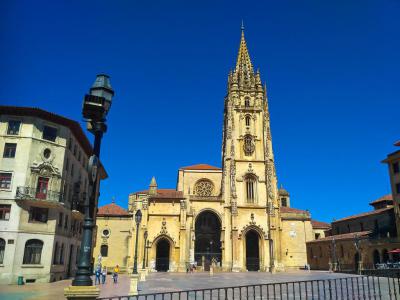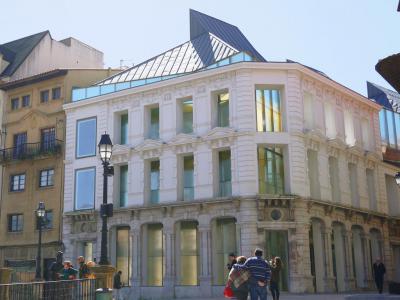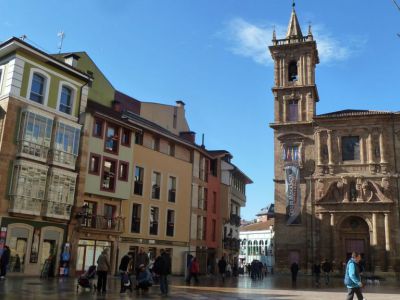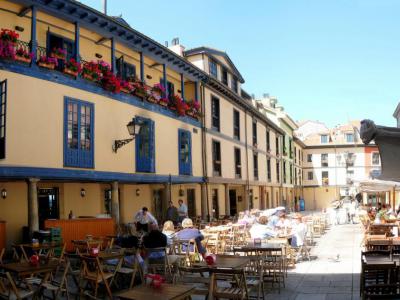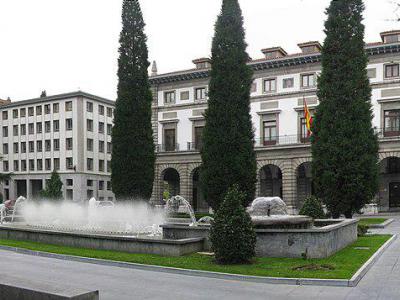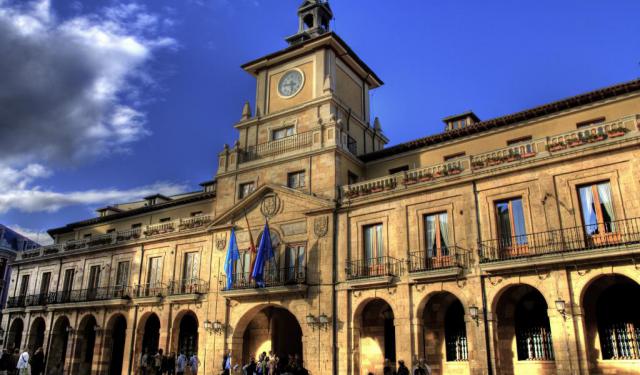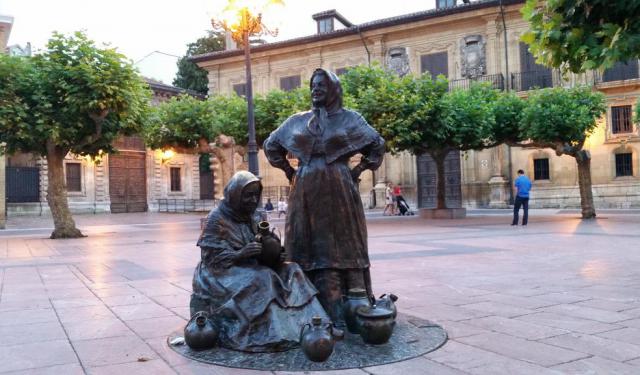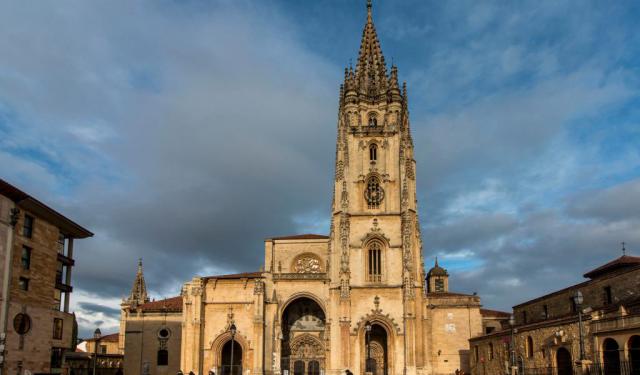
Oviedo Introduction Walking Tour (Self Guided), Oviedo
The Kingdom of Asturias began in 720, with the Visigothic revolt against Muslim rule led by the nobleman Pelagius. At that time, the city of Oviedo did not exist. Two monks, Maximo and Fromestano, founded the city in 761. They built a small church for Saint Vincent on a bare hillside, and from this seed, Oviedo grew.
After Pelagius died in 737, King Alfonso I founded a dynasty in Oviedo that would last 330 years. Oviedo and Asturias are unique in Spain in that the Moors never invaded this part of the country. The Picos de Europa mountains proved a formidable obstacle for the Moors' army. While the struggles of the Reconquista would continue for another 455 years, the grand architectural traditions of Oviedo had begun in the 8th century.
The kings of the 8th-11th centuries busied themselves with building. The Church of San Salvador formed the heart of Oviedo. The Pilgrim route of Santiago passed through town. The Churches of Santa Maria Naranco and San Miguel de Lillo appeared.
The city walls and aqueduct were built during the 12th to 16th centuries. The University of Oviedo was created in 1574. In the 17th-19th centuries, Oviedo expanded into a major urban center. Grand palaces were built by the nobility. Industrial growth in the 19th century created suburban and commercial development around Uria Street.
Among the historical architectural sites accessible in the Old City center are Camara Santa (or "Holy Chamber") in year 802; St Mary of Naranco and San Miguel de Lillo in the 9th century; the well-preserved San Julian de los Prados in year 842; and the high towered Cathedral of San Salvador in 1388.
Oviedo is a city of plazas. Each has architecture, real-life sculptures, music and dancing, and festivals. At Christmas, the Three kings of the East journey to Cathedral Square. For seven days in September, the streets are filled with music and performances. The Wine fiesta is in October.
On Saturdays and Sundays, bagpipe bands play near Cathedral Square. Come, eat and drink and dance to the tunes of Oviedo.
After Pelagius died in 737, King Alfonso I founded a dynasty in Oviedo that would last 330 years. Oviedo and Asturias are unique in Spain in that the Moors never invaded this part of the country. The Picos de Europa mountains proved a formidable obstacle for the Moors' army. While the struggles of the Reconquista would continue for another 455 years, the grand architectural traditions of Oviedo had begun in the 8th century.
The kings of the 8th-11th centuries busied themselves with building. The Church of San Salvador formed the heart of Oviedo. The Pilgrim route of Santiago passed through town. The Churches of Santa Maria Naranco and San Miguel de Lillo appeared.
The city walls and aqueduct were built during the 12th to 16th centuries. The University of Oviedo was created in 1574. In the 17th-19th centuries, Oviedo expanded into a major urban center. Grand palaces were built by the nobility. Industrial growth in the 19th century created suburban and commercial development around Uria Street.
Among the historical architectural sites accessible in the Old City center are Camara Santa (or "Holy Chamber") in year 802; St Mary of Naranco and San Miguel de Lillo in the 9th century; the well-preserved San Julian de los Prados in year 842; and the high towered Cathedral of San Salvador in 1388.
Oviedo is a city of plazas. Each has architecture, real-life sculptures, music and dancing, and festivals. At Christmas, the Three kings of the East journey to Cathedral Square. For seven days in September, the streets are filled with music and performances. The Wine fiesta is in October.
On Saturdays and Sundays, bagpipe bands play near Cathedral Square. Come, eat and drink and dance to the tunes of Oviedo.
How it works: Download the app "GPSmyCity: Walks in 1K+ Cities" from Apple App Store or Google Play Store to your mobile phone or tablet. The app turns your mobile device into a personal tour guide and its built-in GPS navigation functions guide you from one tour stop to next. The app works offline, so no data plan is needed when traveling abroad.
Oviedo Introduction Walking Tour Map
Guide Name: Oviedo Introduction Walking Tour
Guide Location: Spain » Oviedo (See other walking tours in Oviedo)
Guide Type: Self-guided Walking Tour (Sightseeing)
# of Attractions: 9
Tour Duration: 1 Hour(s)
Travel Distance: 1.8 Km or 1.1 Miles
Author: Xena
Sight(s) Featured in This Guide:
Guide Location: Spain » Oviedo (See other walking tours in Oviedo)
Guide Type: Self-guided Walking Tour (Sightseeing)
# of Attractions: 9
Tour Duration: 1 Hour(s)
Travel Distance: 1.8 Km or 1.1 Miles
Author: Xena
Sight(s) Featured in This Guide:
- Cathedral of San Salvador
- Museum of Fine Arts of Asturias
- Plaza de la Constitución (Constitution Square)
- Plaza del Fontán (Fontan Square)
- Vendedoras del Fontán (Sellers of the Fontán)
- Junta General del Principado des Asturias (Parliament of the Principality of Asturias)
- Campo de San Francisco (San Francisco Park)
- Plaza de España (Spain Square)
- Calle Uria (Uría Street)
1) Cathedral of San Salvador (must see)
Alfonso II, king of Asturias, discovered the supposed tomb of Saint James the Greater in the town of Compostela in the eighth century. During his reign, Alfonso II built the Holy Chamber, Alfonso's chapel, and the treasury for the Cathedral of San Salvador in Oviedo, Asturias region of northern Spain.
The Cathedral of San Salvador, also known as the Metropolitan Cathedral Basilica of the Holy Saviour, is a Roman Catholic Church and a basilica in the center of Oviedo. Today, it features many architectural styles, from Pre-Romanesque to Baroque, including Romanesque, Gothic, and Renaissance elements.
The Holy Chamber is a two-story pre-Romanesque structure built on a rectangular plan. It serves as the treasury of the new cathedral of San Salvador. Royal burials are on the ground floor. The upper floor holds a collection of relics and royal treasures.
The aisle of the upper floor of the Chamber has twelve Romanesque columns depicting the apostles. The columns support the barrel vault roof. The Romanesque Old Tower belfry is raised by the addition of an arched gallery with a ribbed vault. There is evidence of a Romanesque cloister, replaced by the Gothic cloister of today.
In the late Middle Ages, the Oviedo Cathedral underwent so many changes that it became a new cathedral complex. Pre-Romanesque basilica and its environs were replaced. Gothic elements prevailed in the chapter room, cloister, master chapel, aisles, facade, and tower.
The church has three naves and side chapels, a transept, and a Renaissance ambulatory. The cathedral roof is supported by tall columns decorated with plant motifs. The altarpiece tells the story of Christ in Flemish-Gothic style pictures. The chapel of King Casto holds a pantheon for deceased Asturian royalty.
There is an old saying in Asturia: "Whoever goes to Santiago and not to the Savior, visits the servant and leaves the master." The master, of course, is the Cathedral of San Salvador.
The Cathedral of San Salvador, also known as the Metropolitan Cathedral Basilica of the Holy Saviour, is a Roman Catholic Church and a basilica in the center of Oviedo. Today, it features many architectural styles, from Pre-Romanesque to Baroque, including Romanesque, Gothic, and Renaissance elements.
The Holy Chamber is a two-story pre-Romanesque structure built on a rectangular plan. It serves as the treasury of the new cathedral of San Salvador. Royal burials are on the ground floor. The upper floor holds a collection of relics and royal treasures.
The aisle of the upper floor of the Chamber has twelve Romanesque columns depicting the apostles. The columns support the barrel vault roof. The Romanesque Old Tower belfry is raised by the addition of an arched gallery with a ribbed vault. There is evidence of a Romanesque cloister, replaced by the Gothic cloister of today.
In the late Middle Ages, the Oviedo Cathedral underwent so many changes that it became a new cathedral complex. Pre-Romanesque basilica and its environs were replaced. Gothic elements prevailed in the chapter room, cloister, master chapel, aisles, facade, and tower.
The church has three naves and side chapels, a transept, and a Renaissance ambulatory. The cathedral roof is supported by tall columns decorated with plant motifs. The altarpiece tells the story of Christ in Flemish-Gothic style pictures. The chapel of King Casto holds a pantheon for deceased Asturian royalty.
There is an old saying in Asturia: "Whoever goes to Santiago and not to the Savior, visits the servant and leaves the master." The master, of course, is the Cathedral of San Salvador.
2) Museum of Fine Arts of Asturias (must see)
The idea of the Fine Arts Museum of Asturias was conceived in 1969 with the formation of the Public Foundation, Regional Center for the Fine Arts. Art museums were not new in Spain, as National fine arts venues could be found in most major cities. Museums in Asturia aimed to promote and celebrate regional and local fine arts.
On May 19, 1980, the fine arts gallery of Asturias was inaugurated. At that moment, it consisted of seven exhibition rooms showing 78 works of art. The Velarde Palace, built in 1770, was acquired and remodeled by architect Florencio Muniz Uribe between 1973 and 1976. The Palace joined with the Oviedo-Portal House (1660), and five adjacent buildings were remodeled between 1993 and 1996 by architects Jorge Hevia and Cosme Cuenca.
A few years later, at the end of the 1990es, talks about the need for a new extension began. The Modern Wing of the museum, designed by architect Francisco Mangado, was inaugurated in 2015. The Wing building stands on the plots of the five buildings acquired on Rua Street. A great feature of the Wing is its double facade. The Modern Wing is wrapped in historical buildings. Bits of the New Wing peep through gaps in the old walls. "Empty spaces" within the Wing are created with courtyards and skylights.
Today, the Museum of Fine Arts holds more than 15,000 works of art, including Asturias and Spanish artists, ranging from El Greco, Zurbaran, and Murillo to Picasso, Miro, and Dali. Baroque and modern sculptures, drawings, posters, and over 1,000 photos stand out.
The museum is open from Tuesday to Saturday. Sundays and holiday hours are 10:30 am to 2:30 pm. Admission is free.
On May 19, 1980, the fine arts gallery of Asturias was inaugurated. At that moment, it consisted of seven exhibition rooms showing 78 works of art. The Velarde Palace, built in 1770, was acquired and remodeled by architect Florencio Muniz Uribe between 1973 and 1976. The Palace joined with the Oviedo-Portal House (1660), and five adjacent buildings were remodeled between 1993 and 1996 by architects Jorge Hevia and Cosme Cuenca.
A few years later, at the end of the 1990es, talks about the need for a new extension began. The Modern Wing of the museum, designed by architect Francisco Mangado, was inaugurated in 2015. The Wing building stands on the plots of the five buildings acquired on Rua Street. A great feature of the Wing is its double facade. The Modern Wing is wrapped in historical buildings. Bits of the New Wing peep through gaps in the old walls. "Empty spaces" within the Wing are created with courtyards and skylights.
Today, the Museum of Fine Arts holds more than 15,000 works of art, including Asturias and Spanish artists, ranging from El Greco, Zurbaran, and Murillo to Picasso, Miro, and Dali. Baroque and modern sculptures, drawings, posters, and over 1,000 photos stand out.
The museum is open from Tuesday to Saturday. Sundays and holiday hours are 10:30 am to 2:30 pm. Admission is free.
3) Plaza de la Constitución (Constitution Square)
Constitution Square is one of the two most important squares of Oviedo. It is broad, full of life, and paved with stone. It is bordered by the 17th-century Town Hall and the Saint Isidor Church. The square was designed by architect Marcos de Velasco Aguero in 1659.
The name of the square has changed to suit political fashions over time. It has been known successively as City Square, Main Square, and Royal Square. In 1873 it became Republic Square as soon as King Amadeo I of Spain abdicated his throne.
The Town Hall in the Square is majestic in size. It was built using the medieval wall that wrapped around Oviedo. The central arch of the Hall, called Cimadevilla Arch, is used by pilgrims on their walk of the Pilgrim's Way to Santiago and the tomb of Saint James.
A 19th-century stone lion guards the arch. Elegant, Baroque Saint Isidor Church dominates the west side of the square. Consecrated in 1681, it raises its high, pointed bell tower next to the El Fontan Market.
The square is the nexus of several fascinating streets and byways. The visitors can see the remains of the city's medieval wall on Weight Street (Calle del Peso). Sun Street (Calle Sol) leads to Trascorrales Square. The Iron Street (Calle el Fierro) takes one to the El Fontan Market.
The name of the square has changed to suit political fashions over time. It has been known successively as City Square, Main Square, and Royal Square. In 1873 it became Republic Square as soon as King Amadeo I of Spain abdicated his throne.
The Town Hall in the Square is majestic in size. It was built using the medieval wall that wrapped around Oviedo. The central arch of the Hall, called Cimadevilla Arch, is used by pilgrims on their walk of the Pilgrim's Way to Santiago and the tomb of Saint James.
A 19th-century stone lion guards the arch. Elegant, Baroque Saint Isidor Church dominates the west side of the square. Consecrated in 1681, it raises its high, pointed bell tower next to the El Fontan Market.
The square is the nexus of several fascinating streets and byways. The visitors can see the remains of the city's medieval wall on Weight Street (Calle del Peso). Sun Street (Calle Sol) leads to Trascorrales Square. The Iron Street (Calle el Fierro) takes one to the El Fontan Market.
4) Plaza del Fontán (Fontan Square) (must see)
Fontan Square is a pleasant place in the middle of Oviedo’s Old Town. The word "fontan" translates to source spring. From the beginning of the city of Oviedo, the source spring created a natural lagoon on the outskirts of town, supplying the area's water needs. It was soon converted into a recreation area for the town's nobility. While the nobles were entertaining themselves, the peasants came to the square to sell their goods.
The peasants brought dairy products, vegetables, cheeses, chickens, and what-have-you. Soon came craftsmen like farriers, basket makers, leather workers, etc. Everybody was using the pool. Things became unsanitary. In 1559 the spring was capped, and a laundry and fountain were installed. The plaza became the suburban commercial center of Oviedo.
Today the square is a bustling place of daily markets, historic buildings, and a fountain. It is a friendly place for shopping, tasting delicacies, and people-watching. Indoor shops, cafes, and restaurants surround the market square. The popular drink is cider, poured skillfully from overhead by a waiter.
Musical performances take place on weekends. There are bagpipes, flutes, and dancers dressed in traditional costumes, moving to the beat.
The peasants brought dairy products, vegetables, cheeses, chickens, and what-have-you. Soon came craftsmen like farriers, basket makers, leather workers, etc. Everybody was using the pool. Things became unsanitary. In 1559 the spring was capped, and a laundry and fountain were installed. The plaza became the suburban commercial center of Oviedo.
Today the square is a bustling place of daily markets, historic buildings, and a fountain. It is a friendly place for shopping, tasting delicacies, and people-watching. Indoor shops, cafes, and restaurants surround the market square. The popular drink is cider, poured skillfully from overhead by a waiter.
Musical performances take place on weekends. There are bagpipes, flutes, and dancers dressed in traditional costumes, moving to the beat.
5) Vendedoras del Fontán (Sellers of the Fontán)
Two bronze women, one seated, one standing, guard a collection of ceramic ware in the Daoiz and Velarde Square. They are known as the "Sellers of the Fontan." The statue, inaugurated in 1996, is the work of sculptor Amado Gonzales Hevia. The bronze women are one of more than 100 such monuments that populate Oviedo streets.
The urban landscape of the city is adorned with sculptural works. For the most part, they represent personages of particular relevance in a former period. The "Sellers" was inspired by an old photograph of Spanish photographer and painter Adolfo Lopez Arman. It shows two women who have come from Faro to Oviedo to sell ceramics they have made in their home workshop.
The Daoiz and Velarde Square holds part of the Market of Fontan where shoppers of Oviedo may buy agricultural products and artisan goods of Asturias every Thursday and Saturday. Since the civil war, the Market has become the exclusive sphere of women. The sculpture is a realistic scene of the Market in the 18th century.
The urban landscape of the city is adorned with sculptural works. For the most part, they represent personages of particular relevance in a former period. The "Sellers" was inspired by an old photograph of Spanish photographer and painter Adolfo Lopez Arman. It shows two women who have come from Faro to Oviedo to sell ceramics they have made in their home workshop.
The Daoiz and Velarde Square holds part of the Market of Fontan where shoppers of Oviedo may buy agricultural products and artisan goods of Asturias every Thursday and Saturday. Since the civil war, the Market has become the exclusive sphere of women. The sculpture is a realistic scene of the Market in the 18th century.
6) Junta General del Principado des Asturias (Parliament of the Principality of Asturias)
The Parliament palace, the organ of the regional government, is situated on Fruela Street. Fruela Street splits off from Uria Street, the Main Street of modern Oviedo, into the historic district of the town. The palace is one of the most talked about, owing to its neoclassical elegance.
The palace was built in 1910 as the palace of Deputies. Provincial architect Nicolas Garcia de Rivero planned and oversaw construction. First, it was necessary to demolish the old medieval Convent of San Francisco, then used it as a hospital.
The building has an opulent dome. Male and female sculptures of science and labor adorn the facade. The whole thing has a French palatial air with modernist bits. The central white marble staircase is grandiloquent with two columns topped with lions. The patio is covered with stained glass. Inside, the Europe and Constitution rooms stand out.
The palace was built in 1910 as the palace of Deputies. Provincial architect Nicolas Garcia de Rivero planned and oversaw construction. First, it was necessary to demolish the old medieval Convent of San Francisco, then used it as a hospital.
The building has an opulent dome. Male and female sculptures of science and labor adorn the facade. The whole thing has a French palatial air with modernist bits. The central white marble staircase is grandiloquent with two columns topped with lions. The patio is covered with stained glass. Inside, the Europe and Constitution rooms stand out.
7) Campo de San Francisco (San Francisco Park) (must see)
San Francisco Park (Campo de San Francisco) is a large public garden of 90,000 square meters in the center of Oviedo. The park is planted with orchards salvaged from the convent of San Francisco after the convent was demolished. The park abounds in winding paths and broad avenues, illuminated by lampposts as the sun sets. The Los Alamos and Jose Cuesta walks, Italia and Germany avenues thread their way through the trees.
A 13th-century deed, kept in the Cathedral of Oviedo, declares that knight Don Gonzalo Bernardo de Quirós donated a fountain and meadow to the Franciscan Friars. In 1534 the city and the Cathedral converted all the land into a single space for public use. Walks and tree-lined ways were developed. Italy Avenue was the first promenade to open.
The 19th century saw the final transformation of the San Francisco lands into a rambling, English-style park. A landscape was created with fountains like Las Ranas ( the Frogs) and La Fuentona (the Fountain). In 1899 the bandstand was built.
Urban sculptures are scattered throughout the park. The Romanesque portal of the old church of San Isidro and other monuments are part of the open-air museum of Oviedo. Busts of famous people are easily found. The park is a refuge. Peacocks, peahens, and aquatic birds stroll or waddle around the lakes and grounds.
In the last few years, adaptations have been carried out to improve the space. All the paved streets have been pedestrianized. Best of all, there will always be ice cream, peacocks, and a safe place to walk.
A 13th-century deed, kept in the Cathedral of Oviedo, declares that knight Don Gonzalo Bernardo de Quirós donated a fountain and meadow to the Franciscan Friars. In 1534 the city and the Cathedral converted all the land into a single space for public use. Walks and tree-lined ways were developed. Italy Avenue was the first promenade to open.
The 19th century saw the final transformation of the San Francisco lands into a rambling, English-style park. A landscape was created with fountains like Las Ranas ( the Frogs) and La Fuentona (the Fountain). In 1899 the bandstand was built.
Urban sculptures are scattered throughout the park. The Romanesque portal of the old church of San Isidro and other monuments are part of the open-air museum of Oviedo. Busts of famous people are easily found. The park is a refuge. Peacocks, peahens, and aquatic birds stroll or waddle around the lakes and grounds.
In the last few years, adaptations have been carried out to improve the space. All the paved streets have been pedestrianized. Best of all, there will always be ice cream, peacocks, and a safe place to walk.
8) Plaza de España (Spain Square)
The Spain Square in Oviedo houses the monument dedicated to the late Dictator of Spain, Generalisimo Francisco Franco. The sculptural composition of three mythological figures is the work of Madrid sculptor Juan de Avalos. The work was inaugurated in 1977, before the new constitution and after Dictator Franco departed this world.
The composition in bronze features Neptune seated on a dolphin to the right of the steps. Apollo strides along, looking at the sky. In the center, as befits her status, sits Hera, queen of the gods and wife of philandering Zeus, Lord of All. There used to be a disk with Hera with an effigy honoring Franco, but that has been removed.
There is a central fountain in the Square. It is specially designed to complement the space given to the civil and military buildings around the area. It is a rectangular central pond with two smaller squares on either side. Each pool has a playing fountain. The fountain complex is set among trees and flowering shrubs.
Around the Square are buildings of the Government Delegation of Asturias, several ministerial delegations, and ministries of the Principality.
The composition in bronze features Neptune seated on a dolphin to the right of the steps. Apollo strides along, looking at the sky. In the center, as befits her status, sits Hera, queen of the gods and wife of philandering Zeus, Lord of All. There used to be a disk with Hera with an effigy honoring Franco, but that has been removed.
There is a central fountain in the Square. It is specially designed to complement the space given to the civil and military buildings around the area. It is a rectangular central pond with two smaller squares on either side. Each pool has a playing fountain. The fountain complex is set among trees and flowering shrubs.
Around the Square are buildings of the Government Delegation of Asturias, several ministerial delegations, and ministries of the Principality.
9) Calle Uria (Uría Street)
Anywhere else, Uria Street might be called "High Street." It is home to many fashion retailers and perhaps the main stretch of Oviedo. It lies along beautiful San Francisco Park, housing restaurants, bars, cafes, patisseries, and the El Corte Inglés department store. The sidewalks are wide and ideal for strolling.
Among the landmarks to admire on the street is the Casa Blanca, the White House. It looms over the middle section of the street, a high, white building with Art Deco designs. Four joined buildings of the Casas del Cuitu (Cuitu's Houses) complex share a neo-Baroque facade. The old Aramo Cinema, built in 1941, is an example of functionalism.
Other sights in the area not to be missed are San Juan Church, Asturias Casino, the Campoamor Theater, and the statue of Woody Allen, hands in pockets, strolling along. Oviedo was a location for his movie "Vicky, Cristina, Barcelona."
From the southeastern part of the street, there are good views of neighboring San Francisco Park. It is the city's foremost green space. It was developed from a medieval monastery and laid out as a park in the 19th century. The street is named for Oviedo's 19th-century writer and politician, Jose Francisco Uria y Riego.
Among the landmarks to admire on the street is the Casa Blanca, the White House. It looms over the middle section of the street, a high, white building with Art Deco designs. Four joined buildings of the Casas del Cuitu (Cuitu's Houses) complex share a neo-Baroque facade. The old Aramo Cinema, built in 1941, is an example of functionalism.
Other sights in the area not to be missed are San Juan Church, Asturias Casino, the Campoamor Theater, and the statue of Woody Allen, hands in pockets, strolling along. Oviedo was a location for his movie "Vicky, Cristina, Barcelona."
From the southeastern part of the street, there are good views of neighboring San Francisco Park. It is the city's foremost green space. It was developed from a medieval monastery and laid out as a park in the 19th century. The street is named for Oviedo's 19th-century writer and politician, Jose Francisco Uria y Riego.
Walking Tours in Oviedo, Spain
Create Your Own Walk in Oviedo
Creating your own self-guided walk in Oviedo is easy and fun. Choose the city attractions that you want to see and a walk route map will be created just for you. You can even set your hotel as the start point of the walk.
Oviedo Historic Architecture
The north Spanish region of Asturias and particularly its capital city, Oviedo, have long been noted for their unique architecture. The medieval part of town, whose ancient walls are still largely intact, contains some truly priceless relics. Among them is a well called La Foncalada, a fascinating example of an effective hydraulic system, dating back to the first half of the 9th century, based on... view more
Tour Duration: 2 Hour(s)
Travel Distance: 2.7 Km or 1.7 Miles
Tour Duration: 2 Hour(s)
Travel Distance: 2.7 Km or 1.7 Miles
Oviedo Public Art Walking Tour
Public art adds a great deal of vibrancy and character to the cityscape of Oviedo, Spain, reflecting, among other things, its contemporary spirit. From the bustling Plaza Trascorrales to the serene Plaza Porlier De Oviedo, numerous sculptures have long become an integral part of the neighborhood, captivating passers-by in their numbers.
In Plaza Trascorrales, sculptures like The Fishwife and... view more
Tour Duration: 3 Hour(s)
Travel Distance: 3.0 Km or 1.9 Miles
In Plaza Trascorrales, sculptures like The Fishwife and... view more
Tour Duration: 3 Hour(s)
Travel Distance: 3.0 Km or 1.9 Miles
The Most Popular Cities
/ view all
